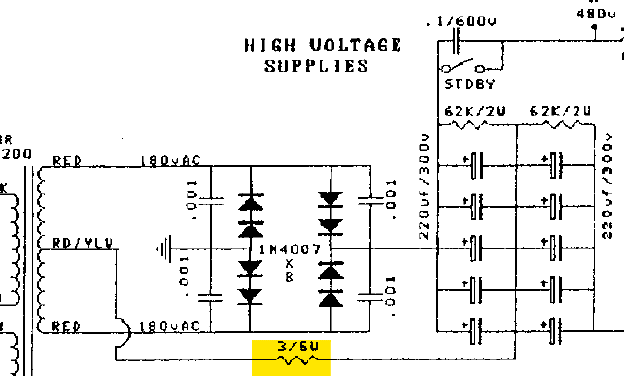chevaliernoir
Member
- Joined
- Aug 25, 2024
- Messages
- 14
- Reaction score
- 2
PROLOGUE
I have a Mesa Boogie 400+. I've tinkered with it a bit but haven’t done any major work, except for building a nice box to protect it.
PURCHASE DECISION
I’ve been talking for a while with a seller in Toulouse who has a broken 400+. His "buddy who knows his stuff" determined that the output transformer is shot. The part is nearly impossible to find and super expensive. The tubes installed are Mesa Boogie, so they’re probably original, meaning at best, I’ll need to replace the output transformer (€400) and retube it (€450). Even though these amps typically sell for over €1000, repairing one in this condition isn’t really cost-effective, especially since there could be other hidden damages (you see where this is going?).
At the same time, I spotted another one on Reverb, from a shop in Lyon, with some burnt components and no tubes, but priced at the cost of a new output transformer. So, in the same week, I received the one from Lyon and went to pick up the one from Toulouse. My car trunk is a mess...

DIAGNOSTIC
Today, I’m taking a closer look... The Lyon amp is in really bad shape.
A broken pot, missing EQ knobs, and, most importantly, badly damaged electronics and cut wires:
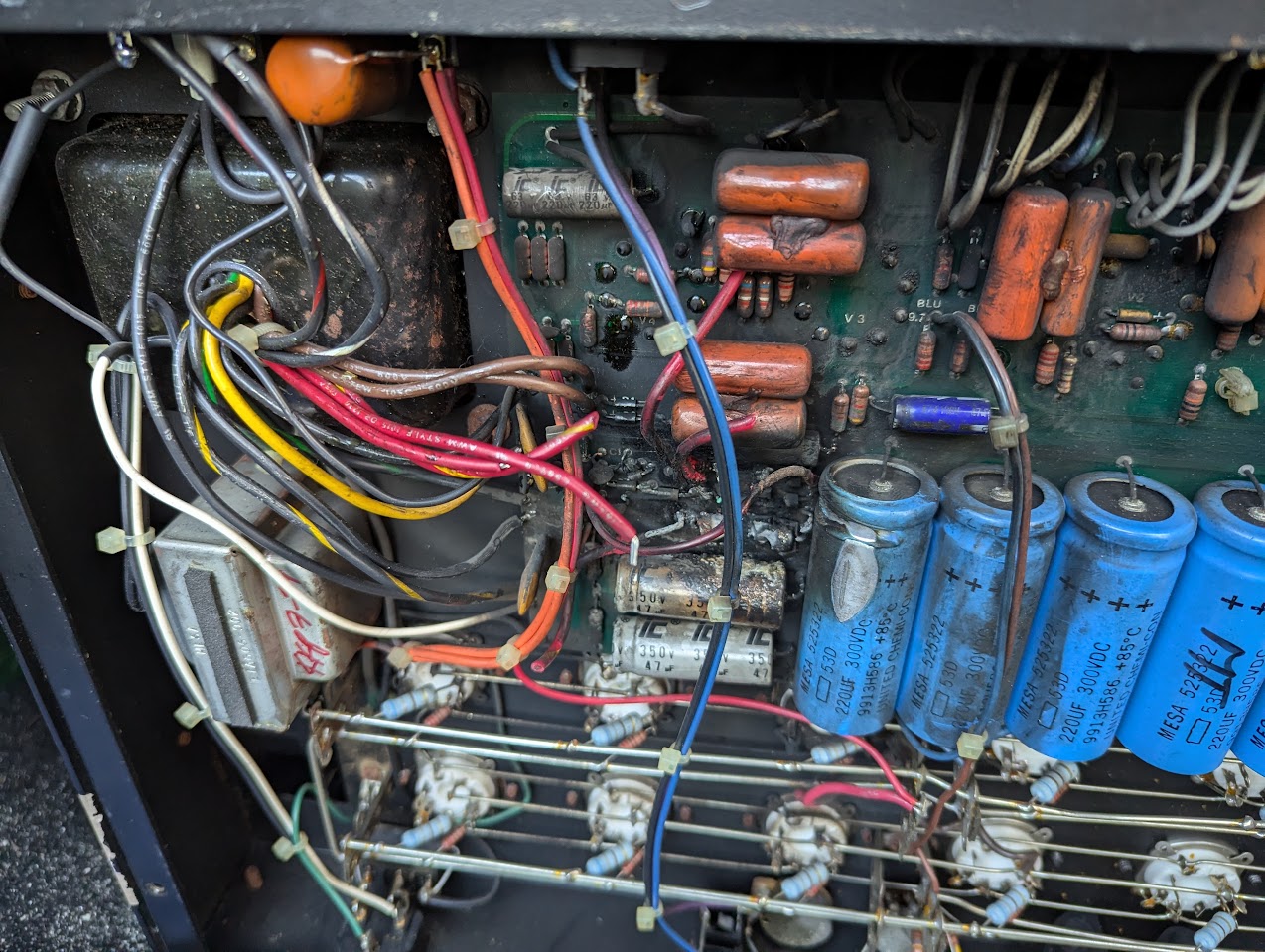
In comparison, the Toulouse amp has a damaged front panel, but the electronics look brand new:

I’m going to try to restore the Toulouse amp and make it as pristine as possible, including the aesthetics, and we’ll see if the other one has any chance of revival or if it will just serve as a donor for parts and be sold piece by piece online.
DIAGNOSIS
Since the output transformer is supposedly dead, before plugging anything in, I remove all the tubes, measure the transformer’s impedance, and... the transformer seems just fine! In fact, the other amp has the same impedances.
After removing the tubes, I see that there are indeed only Mesa Boogie tubes, but some with gold lettering, others with silver, and the power tubes aren’t matched... Clearly, this amp has had some use.
From what I understand about Mesa Boogie power tubes, they’re identified by color (red, gray, green, blue...) so you just need to install tubes of the same color to avoid any matching issues. You can order JJ tubes with the corresponding Mesa color code. Great. If you see things differently, let me know, I’m eager to learn.
After a visual inspection where I don’t detect any tampering, and everything looks clean and original, I put in a new fuse, plug it in, and switch it to ON for a second. The fuse blows instantly.
I desolder the transformer outputs that supply high voltage to the power stage (180V AC) and power it on again. The fuse blows instantly (again and again).

I desolder the transformer wires that provide the negative power supply (60VAC). The fuse blows instantly (again and again and again).


I desolder the transformer wires that power the tube heaters (6.3V AC). The fuse blows instantly (again and again and again and again and again).



In short, the transformer is now powering nothing, so it must have an internal short circuit. It’s not the output transformer but the power transformer that’s dead. Too easy.
PLOT TWIST
While searching for documentation on the power transformer, I came across this great document describing the 220V and 110V configurations...
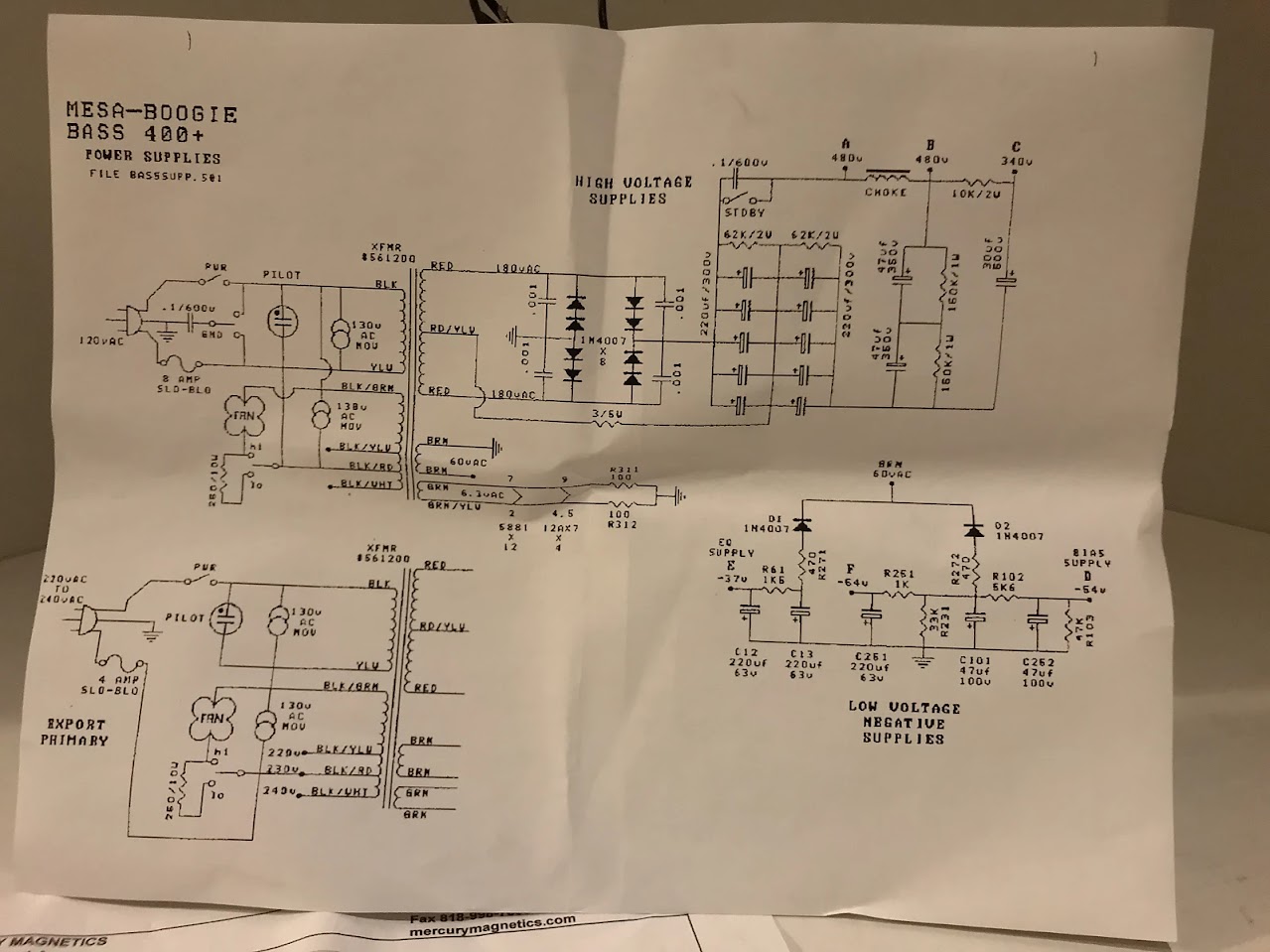
So I check my amps and... the two amps don’t have the same configuration!
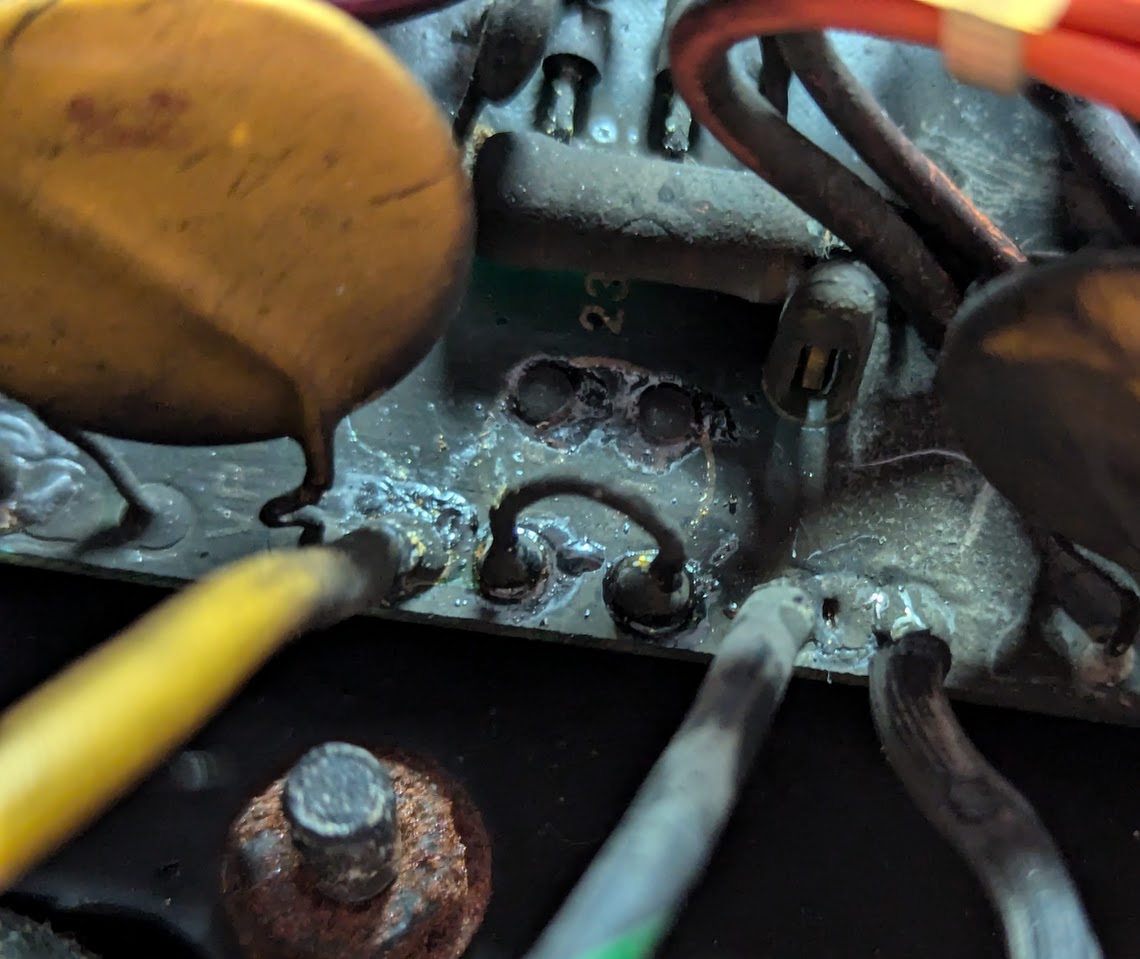
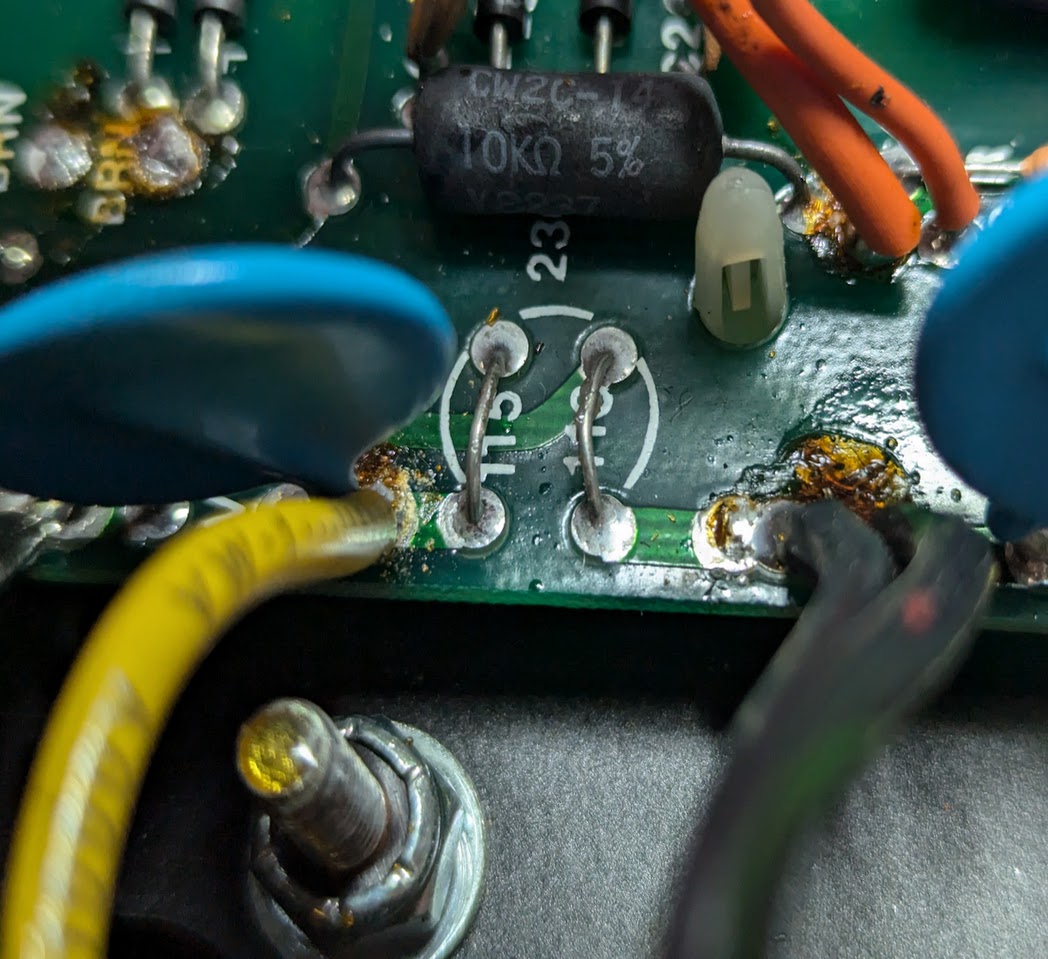
And it’s the one in good condition, the Toulouse one, that seems to be set up for 110V.
I’m going to switch everything back to 240V, but I’m wondering how well the fuse protected the electronics or if I’m about to discover a bunch of broken components everywhere!
Stay tuned for the next episode...
I have a Mesa Boogie 400+. I've tinkered with it a bit but haven’t done any major work, except for building a nice box to protect it.
PURCHASE DECISION
I’ve been talking for a while with a seller in Toulouse who has a broken 400+. His "buddy who knows his stuff" determined that the output transformer is shot. The part is nearly impossible to find and super expensive. The tubes installed are Mesa Boogie, so they’re probably original, meaning at best, I’ll need to replace the output transformer (€400) and retube it (€450). Even though these amps typically sell for over €1000, repairing one in this condition isn’t really cost-effective, especially since there could be other hidden damages (you see where this is going?).
At the same time, I spotted another one on Reverb, from a shop in Lyon, with some burnt components and no tubes, but priced at the cost of a new output transformer. So, in the same week, I received the one from Lyon and went to pick up the one from Toulouse. My car trunk is a mess...
DIAGNOSTIC
Today, I’m taking a closer look... The Lyon amp is in really bad shape.
A broken pot, missing EQ knobs, and, most importantly, badly damaged electronics and cut wires:
In comparison, the Toulouse amp has a damaged front panel, but the electronics look brand new:
I’m going to try to restore the Toulouse amp and make it as pristine as possible, including the aesthetics, and we’ll see if the other one has any chance of revival or if it will just serve as a donor for parts and be sold piece by piece online.
DIAGNOSIS
Since the output transformer is supposedly dead, before plugging anything in, I remove all the tubes, measure the transformer’s impedance, and... the transformer seems just fine! In fact, the other amp has the same impedances.
After removing the tubes, I see that there are indeed only Mesa Boogie tubes, but some with gold lettering, others with silver, and the power tubes aren’t matched... Clearly, this amp has had some use.
From what I understand about Mesa Boogie power tubes, they’re identified by color (red, gray, green, blue...) so you just need to install tubes of the same color to avoid any matching issues. You can order JJ tubes with the corresponding Mesa color code. Great. If you see things differently, let me know, I’m eager to learn.
After a visual inspection where I don’t detect any tampering, and everything looks clean and original, I put in a new fuse, plug it in, and switch it to ON for a second. The fuse blows instantly.
I desolder the transformer outputs that supply high voltage to the power stage (180V AC) and power it on again. The fuse blows instantly (again and again).
I desolder the transformer wires that provide the negative power supply (60VAC). The fuse blows instantly (again and again and again).
I desolder the transformer wires that power the tube heaters (6.3V AC). The fuse blows instantly (again and again and again and again and again).
In short, the transformer is now powering nothing, so it must have an internal short circuit. It’s not the output transformer but the power transformer that’s dead. Too easy.
PLOT TWIST
While searching for documentation on the power transformer, I came across this great document describing the 220V and 110V configurations...
So I check my amps and... the two amps don’t have the same configuration!
And it’s the one in good condition, the Toulouse one, that seems to be set up for 110V.
I’m going to switch everything back to 240V, but I’m wondering how well the fuse protected the electronics or if I’m about to discover a bunch of broken components everywhere!
Stay tuned for the next episode...






